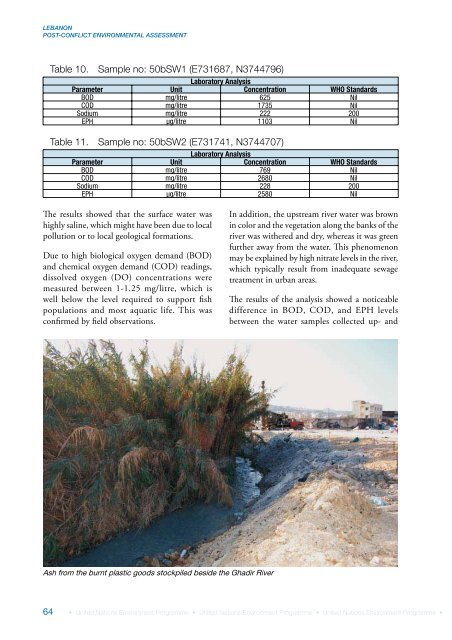- Page 1:
LebanonPost-Conflict Environmental
- Page 6 and 7:
LEBANONPOST-CONFLICT ENVIRONMENTAL
- Page 8:
IntroductionFrench navy experts on
- Page 11 and 12:
INTRODUCTIONUNEP expert assessing d
- Page 14 and 15: LEBANONPOST-CONFLICT ENVIRONMENTAL
- Page 16 and 17: LEBANONPOST-CONFLICT ENVIRONMENTAL
- Page 18 and 19: LEBANONPOST-CONFLICT ENVIRONMENTAL
- Page 20 and 21: LEBANONPOST-CONFLICT ENVIRONMENTAL
- Page 22 and 23: LEBANONPOST-CONFLICT ENVIRONMENTAL
- Page 24: EnvironmentalAssessmentUNEP expert
- Page 27 and 28: ENVIRONMENTAL ASSESSMENTMap 4.Sites
- Page 29 and 30: ENVIRONMENTAL ASSESSMENT the Europe
- Page 31 and 32: ENVIRONMENTAL ASSESSMENTStage 2:Dam
- Page 33 and 34: ENVIRONMENTAL ASSESSMENTstructures
- Page 35 and 36: ENVIRONMENTAL ASSESSMENTSolid and h
- Page 37 and 38: ENVIRONMENTAL ASSESSMENTWeapons use
- Page 39 and 40: ENVIRONMENTAL ASSESSMENTOyster and
- Page 42 and 43: LEBANONPOST-CONFLICT ENVIRONMENTAL
- Page 44 and 45: LEBANONPOST-CONFLICT ENVIRONMENTAL
- Page 46 and 47: LEBANONPOST-CONFLICT ENVIRONMENTAL
- Page 48 and 49: LEBANONPOST-CONFLICT ENVIRONMENTAL
- Page 50 and 51: LEBANONPOST-CONFLICT ENVIRONMENTAL
- Page 52 and 53: LEBANONPOST-CONFLICT ENVIRONMENTAL
- Page 54 and 55: LEBANONPOST-CONFLICT ENVIRONMENTAL
- Page 56 and 57: LEBANONPOST-CONFLICT ENVIRONMENTAL
- Page 58 and 59: LEBANONPOST-CONFLICT ENVIRONMENTAL
- Page 60 and 61: LEBANONPOST-CONFLICT ENVIRONMENTAL
- Page 62 and 63: LEBANONPOST-CONFLICT ENVIRONMENTAL
- Page 66 and 67: LEBANONPOST-CONFLICT ENVIRONMENTAL
- Page 68 and 69: LEBANONPOST-CONFLICT ENVIRONMENTAL
- Page 70 and 71: LEBANONPOST-CONFLICT ENVIRONMENTAL
- Page 72 and 73: LEBANONPOST-CONFLICT ENVIRONMENTAL
- Page 74 and 75: LEBANONPOST-CONFLICT ENVIRONMENTAL
- Page 76 and 77: LEBANONPOST-CONFLICT ENVIRONMENTAL
- Page 78 and 79: LEBANONPOST-CONFLICT ENVIRONMENTAL
- Page 80 and 81: LEBANONPOST-CONFLICT ENVIRONMENTAL
- Page 82 and 83: LEBANONPOST-CONFLICT ENVIRONMENTAL
- Page 84 and 85: LEBANONPOST-CONFLICT ENVIRONMENTAL
- Page 86 and 87: LEBANONPOST-CONFLICT ENVIRONMENTAL
- Page 88 and 89: LEBANONPOST-CONFLICT ENVIRONMENTAL
- Page 90 and 91: LEBANONPOST-CONFLICT ENVIRONMENTAL
- Page 92 and 93: LEBANONPOST-CONFLICT ENVIRONMENTAL
- Page 94 and 95: LEBANONPOST-CONFLICT ENVIRONMENTAL
- Page 96 and 97: LEBANONPOST-CONFLICT ENVIRONMENTAL
- Page 98: Solid and HazardousWasteA fleet of
- Page 101 and 102: SOLID AND HAZARDOUS WASTEMap 7.Samp
- Page 103 and 104: SOLID AND HAZARDOUS WASTEvectors, i
- Page 105 and 106: SOLID AND HAZARDOUS WASTEThe Khiam
- Page 107 and 108: SOLID AND HAZARDOUS WASTEThe primar
- Page 109 and 110: SOLID AND HAZARDOUS WASTEThe dump s
- Page 112 and 113: LEBANONPOST-CONFLICT ENVIRONMENTAL
- Page 114 and 115:
LEBANONPOST-CONFLICT ENVIRONMENTAL
- Page 116 and 117:
LEBANONPOST-CONFLICT ENVIRONMENTAL
- Page 118 and 119:
LEBANONPOST-CONFLICT ENVIRONMENTAL
- Page 120 and 121:
LEBANONPOST-CONFLICT ENVIRONMENTAL
- Page 122 and 123:
LEBANONPOST-CONFLICT ENVIRONMENTAL
- Page 124 and 125:
LEBANONPOST-CONFLICT ENVIRONMENTAL
- Page 126 and 127:
LEBANONPOST-CONFLICT ENVIRONMENTAL
- Page 128 and 129:
LEBANONPOST-CONFLICT ENVIRONMENTAL
- Page 130:
Coastal and MarineEnvironmentVolunt
- Page 133 and 134:
Wadi Abu ZebleCOASTAL AND MARINE EN
- Page 135 and 136:
COASTAL AND MARINE ENVIRONMENTMap 1
- Page 137 and 138:
COASTAL AND MARINE ENVIRONMENTThe c
- Page 139 and 140:
COASTAL AND MARINE ENVIRONMENTTable
- Page 141 and 142:
COASTAL AND MARINE ENVIRONMENTMarin
- Page 143 and 144:
COASTAL AND MARINE ENVIRONMENTUNEP
- Page 146 and 147:
LEBANONPOST-CONFLICT ENVIRONMENTAL
- Page 148 and 149:
LEBANONPOST-CONFLICT ENVIRONMENTAL
- Page 150 and 151:
LEBANONPOST-CONFLICT ENVIRONMENTAL
- Page 152 and 153:
LEBANONPOST-CONFLICT ENVIRONMENTAL
- Page 154 and 155:
LEBANONPOST-CONFLICT ENVIRONMENTAL
- Page 156 and 157:
LEBANONPOST-CONFLICT ENVIRONMENTAL
- Page 158 and 159:
LEBANONPOST-CONFLICT ENVIRONMENTAL
- Page 160:
Main Findings andRecommendationsBad
- Page 163 and 164:
MAIN FINDINGS AND RECOMMENDATIONSRe
- Page 165 and 166:
MAIN FINDINGS AND RECOMMENDATIONSbe
- Page 167:
MAIN FINDINGS AND RECOMMENDATIONSsp
- Page 170 and 171:
LEBANONPOST-CONFLICT ENVIRONMENTAL
- Page 172 and 173:
LEBANONPOST-CONFLICT ENVIRONMENTAL
- Page 174 and 175:
LEBANONPOST-CONFLICT ENVIRONMENTAL
- Page 176 and 177:
LEBANONPOST-CONFLICT ENVIRONMENTAL
- Page 178 and 179:
LEBANONPOST-CONFLICT ENVIRONMENTAL
- Page 180 and 181:
LEBANONPOST-CONFLICT ENVIRONMENTAL
- Page 183 and 184:
Further informationCopies of this r
















